Key takeaways:
- Agile methodology fosters flexibility and customer feedback, enhancing collaboration and iterative progress through sprints.
- Embracing change significantly impacts team morale and innovation, transforming challenges into opportunities for growth.
- Clear communication and balanced planning are essential for successful Agile adoption, mitigating risks of miscommunication and chaos.
- Continuous improvement relies on regular reflection, diverse perspectives, and measurable goals to maintain motivation and accountability.
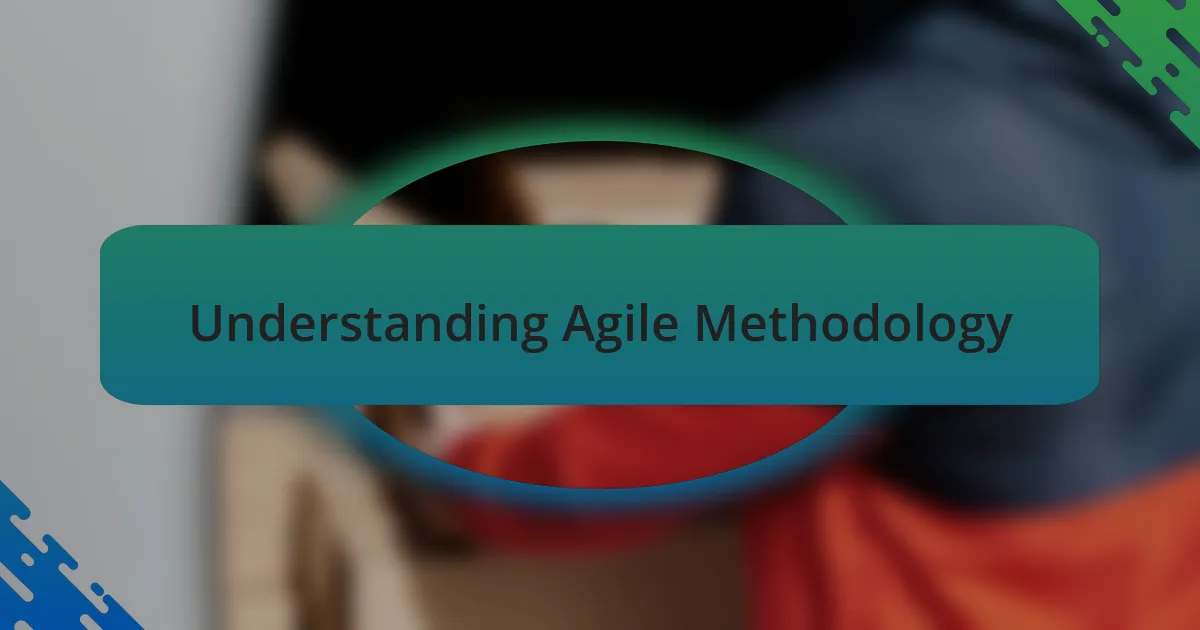
Understanding Agile Methodology
Agile methodology is all about flexibility and responsiveness in software development. I remember when I first encountered Agile in my projects; it was a breath of fresh air compared to the rigid processes I had grown accustomed to. How would our team have developed such innovative features if we hadn’t embraced this dynamic framework?
At its core, Agile emphasizes collaboration and iterative progress through short cycles called sprints. I found that these sprints not only kept the team focused but also fostered a sense of accomplishment, especially when we demonstrated our work at the end of each cycle. There’s something really motivating about seeing tangible results quickly, isn’t there?
One aspect I particularly appreciate about Agile is the emphasis on customer feedback. In my experience, when we actively sought input from stakeholders after each iteration, the final product was more aligned with their needs. I often reflect, how can we truly build something great without genuinely understanding what our users want? This approach nurtured a culture of continuous improvement, making the journey as rewarding as the end goal.
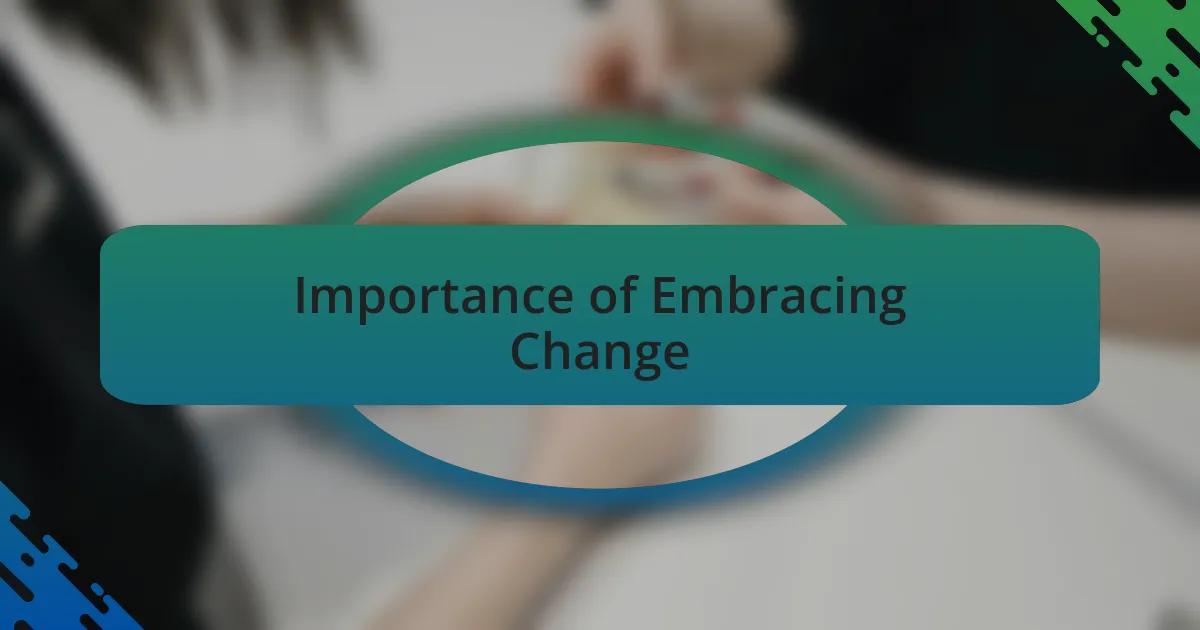
Importance of Embracing Change
Embracing change is crucial in the Agile process because it allows teams to stay relevant in a rapidly evolving landscape. I recall a project where the requirements shifted almost overnight due to market demands. If we hadn’t been willing to adapt, our effort would have been wasted, and we could have easily fallen behind our competitors. Isn’t it fascinating how flexibility can be the deciding factor between success and stagnation?
When I allowed myself to accept change as a part of the process rather than an obstacle, I noticed a shift within my team. There was a newfound enthusiasm as team members began to see changes as opportunities for innovation rather than disruptions. I remember one sprint where a sudden pivot in our feature set led to a groundbreaking solution that we never would have considered in our initial planning stages. How often do we miss out on greatness simply because we resist the unknown?
The emotional impact of embracing change cannot be overstated. I find that when a team leans into change, it cultivates a powerful sense of camaraderie and shared purpose. Reflecting on the times we faced challenges head-on, I see how those moments not only strengthened our bond but also enhanced our overall resilience. Isn’t it empowering to know that our adaptability can lead us to unexpected successes?
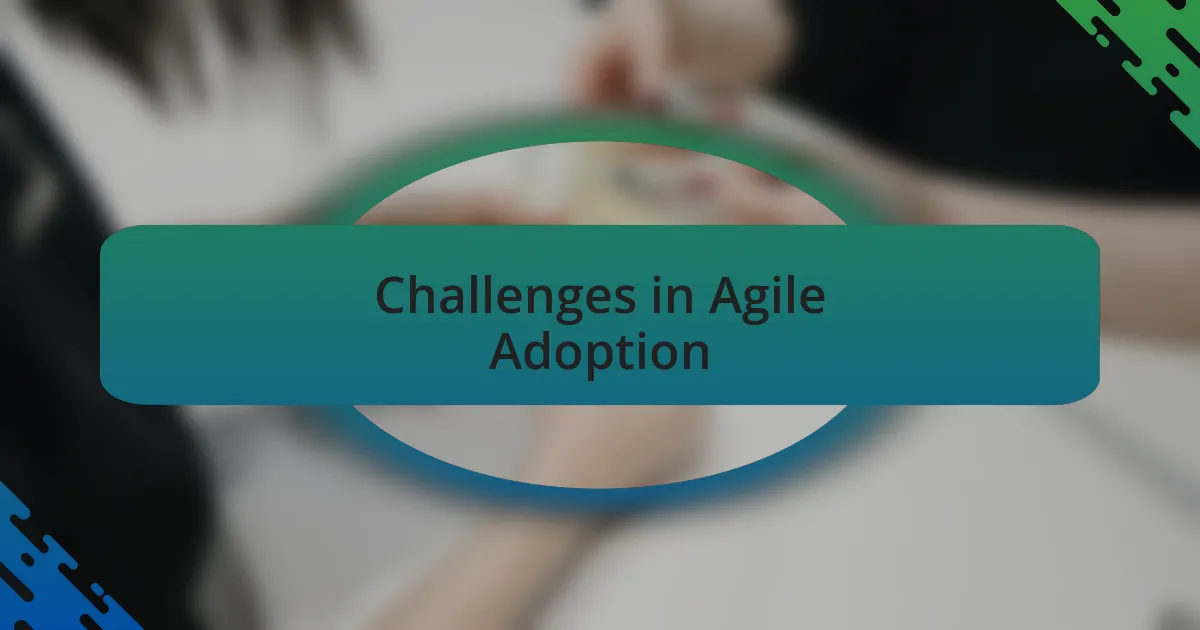
Challenges in Agile Adoption
Adopting Agile practices can be quite a journey, and it’s not without its hurdles. I remember a project kickoff where the team was excited about Agile, but there was a significant resistance from upper management. They struggled to let go of traditional waterfall methodologies, fearing that Agile’s flexibility would lead to chaos. It made me wonder: how can we expect change to flourish if the very foundation of decision-making is hesitant?
One particularly challenging moment for my team involved a miscommunication about sprint goals. This lapse led to frustrations that spiraled into blame-shifting rather than accountability. It was a wake-up call for us; I learned how vital clear communication and shared objectives are in Agile. Who knew that a simple misunderstanding could derail momentum and morale so quickly?
Another obstacle I’ve encountered is the misconception that Agile means no planning at all. I once witnessed a colleague dismiss critical planning sessions, believing they were too rigid for Agile. However, this approach left us scrambling and reactive instead of proactive. Reflecting on this experience, I’ve come to appreciate that effective Agile adoption hinges on balancing flexibility with thoughtful strategy. Isn’t it interesting how defining the right type of structure can actually empower a team?
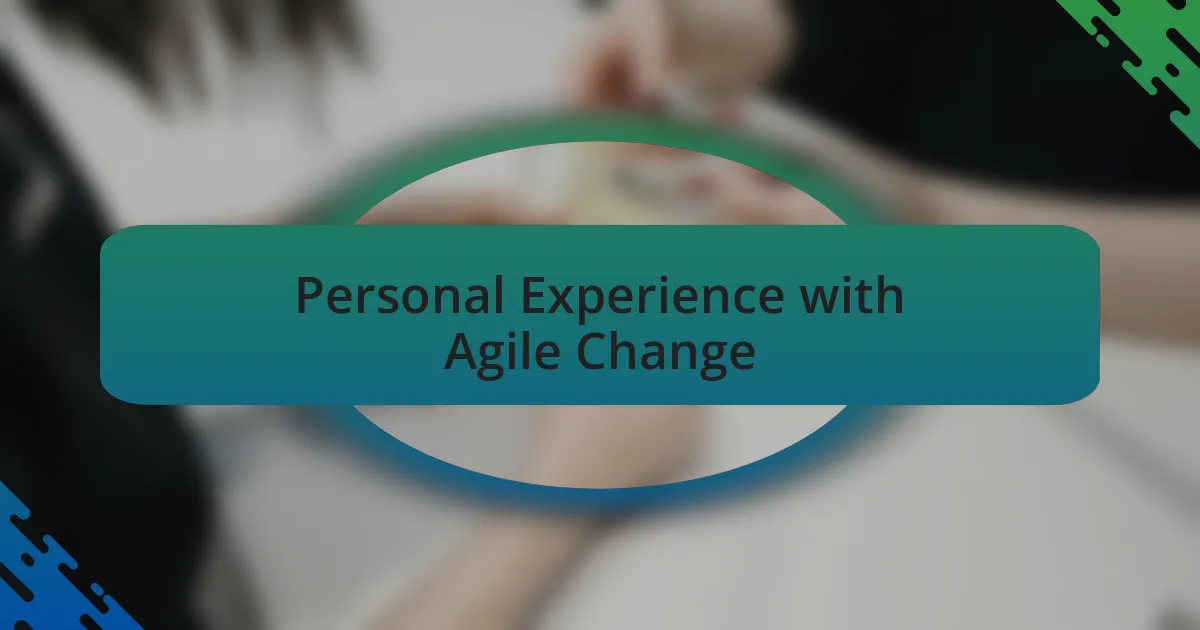
Personal Experience with Agile Change
When I first encountered Agile change, I was both intrigued and apprehensive. I remember transitioning to a new team where Agile was the norm. At first, it felt like stepping into a whirlwind of meetings and stand-ups. But over time, I discovered something profoundly liberating in this chaos—an opportunity for each team member to voice their opinions. Have you ever felt empowered to contribute in ways you didn’t think possible? That was my experience as I embraced Agile practices.
There was a specific sprint where we faced a significant pivot in our project direction due to user feedback. Initially, it was unsettling; we had to scrap parts of our work that we were attached to. Yet, I realized this was a testament to Agile’s adaptability. Instead of viewing change as a setback, I learned to see it as a chance for growth. I vividly recall how the energy in the team shifted as we rallied around our renewed goals. Isn’t it amazing how embracing change can unite a team in unexpected ways?
One memorable instance involved a retrospective meeting that turned into a transformative session for me personally. Early on, I was hesitant to share my thoughts, fearing they would be seen as criticism. But that day, I decided to take a leap of faith and openly discuss my perspective. The support and constructive feedback I received not only boosted my confidence but also fostered a culture of trust within the team. This experience taught me the importance of vulnerability in the Agile process. Why do we often hold back our true feelings in a work environment? Embracing that openness has truly changed the way I approach my collaborative efforts.

Strategies for Adapting to Change
Adapting to change in Agile requires a mindset shift, and one effective strategy I’ve found is embracing the practice of regular reflection. In one particular sprint, our team faced a major setback that would have discouraged anyone. Instead of charging full steam ahead, we paused to reflect on what went wrong. Can you imagine the difference that makes? That simple act of reflection transformed our entire approach, allowing us to learn from mistakes rather than just gloss over them.
Another strategy I’ve employed is encouraging open communication. I remember when a team member proposed a significant change in our workflow that initially felt disruptive. Instead of dismissing it, we held a brainstorming session to discuss its potential benefits. Isn’t it empowering when everyone feels their voice can impact the direction of the project? The result was not only an improved workflow but also a strengthened team bond, as we collaboratively navigated the change.
Lastly, I advocate for creating a flexible mindset toward planning. Once, we had laid out a detailed roadmap for the next few months, yet unforeseen challenges forced us to pivot frequently. It was frustrating at first, but over time, I learned that having an adaptable plan is more valuable than rigid adherence to one. Why hold onto something that no longer serves the project’s best interests? By allowing ourselves to pivot when necessary, we embraced the essence of Agile—flexibility and responsiveness—and ultimately achieved a stronger outcome.
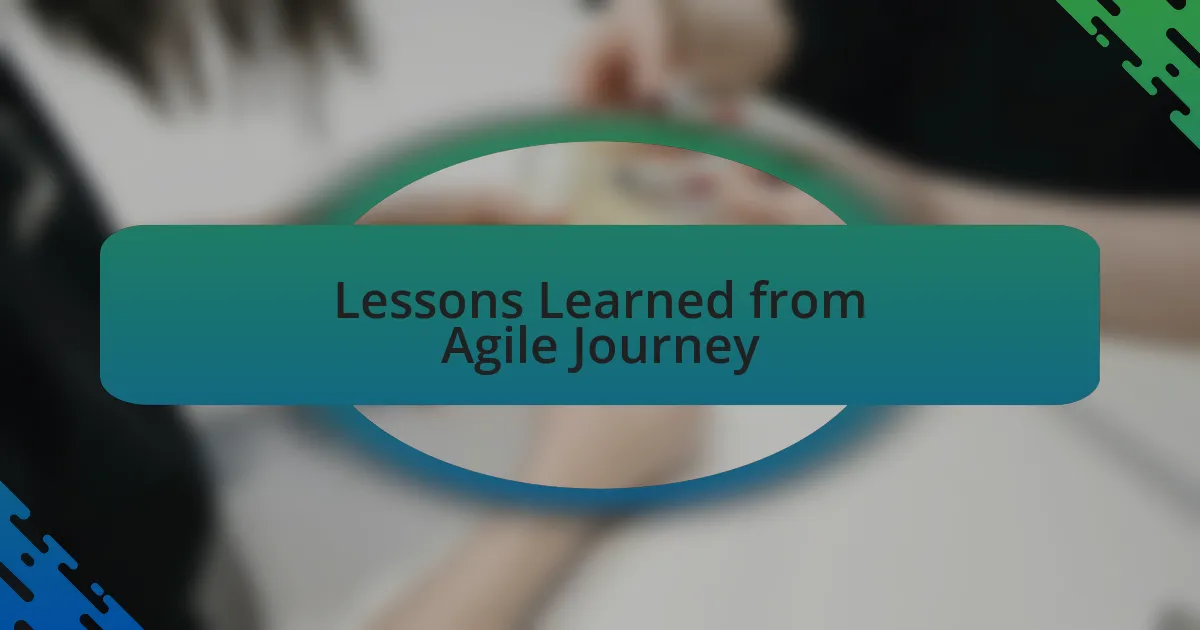
Lessons Learned from Agile Journey
Throughout my Agile journey, one significant lesson learned is that failure is not the end but a crucial stepping stone. I vividly recall a pivotal sprint where our team underestimated the complexity of a feature. The initial reaction was panic and frustration, but that experience taught us the power of resilience. With each misstep, we grew closer as a team and learned to face challenges together. How many times have you witnessed failure leading to unexpected breakthroughs?
Another important realization is the value of feedback loops. Early in my Agile experience, we had a review session where feedback was delivered harshly. It felt disheartening at first, but I came to appreciate how constructive criticism can be a catalyst for growth. By fostering an environment where feedback is seen as a gift rather than an insult, we created a space for continuous improvement. Isn’t it fascinating how a simple shift in perspective can redefine team dynamics?
Finally, I discovered that embracing change goes hand in hand with fostering trust. In one memorable instance, I hesitated to express my concerns about a proposed feature. But once I voiced my thoughts, the team rallied around the idea of incorporating diverse opinions. It was a turning point that emphasized how trust encourages open dialogue, empowering us to tackle challenges more effectively. Have you ever experienced the liberating feeling that comes when teamwork fosters trust during times of change?

Tips for Continuous Improvement
Continuous improvement in Agile is a journey that requires consistent self-reflection and adaptation. One technique that worked wonders for me was holding regular retrospectives with my team. In these meetings, we not only discussed what went wrong but celebrated our successes, no matter how small. This balanced approach helped us maintain motivation and continuously strive for better outcomes. Can you recall a time when focusing on achievements shifted your perspective in a positive way?
Another essential tip is to seek diverse perspectives within your team. I remember a project where I felt strongly about a specific approach, but my colleagues had differing opinions. By creating a safe space for everyone to voice their thoughts, we collectively discovered a solution that transcended any individual idea. Isn’t it intriguing how collaboration can lead to innovative solutions that we might never have considered alone?
Finally, I believe in the importance of setting measurable goals. At one point, we established clear metrics for our sprints, which transformed our evaluation process. This quantifiable approach not only made our progress visible but also generated a healthy sense of accountability. Have you ever noticed how having clear targets can energize a team and give everyone a shared sense of purpose?